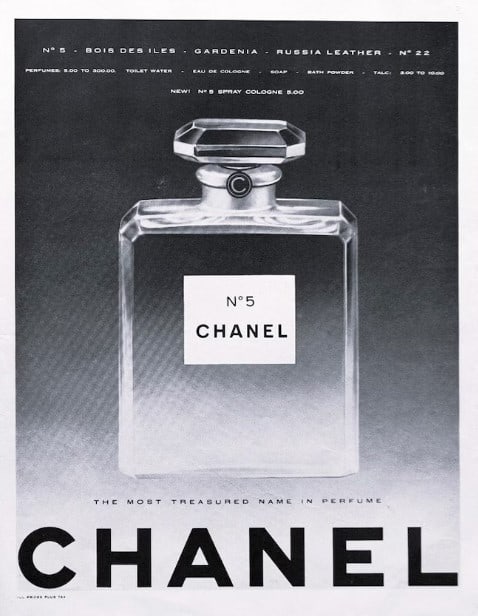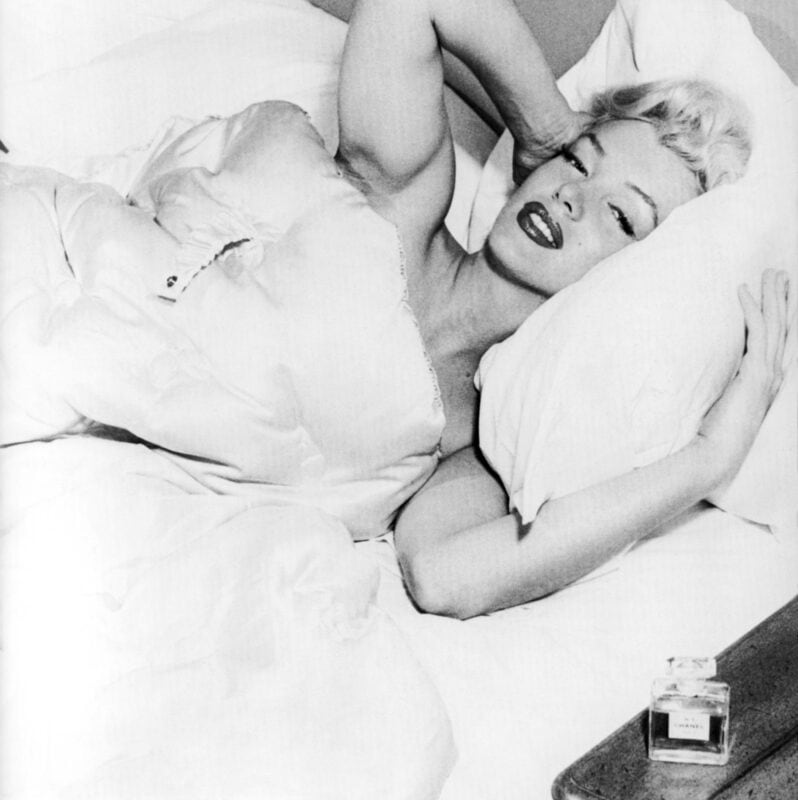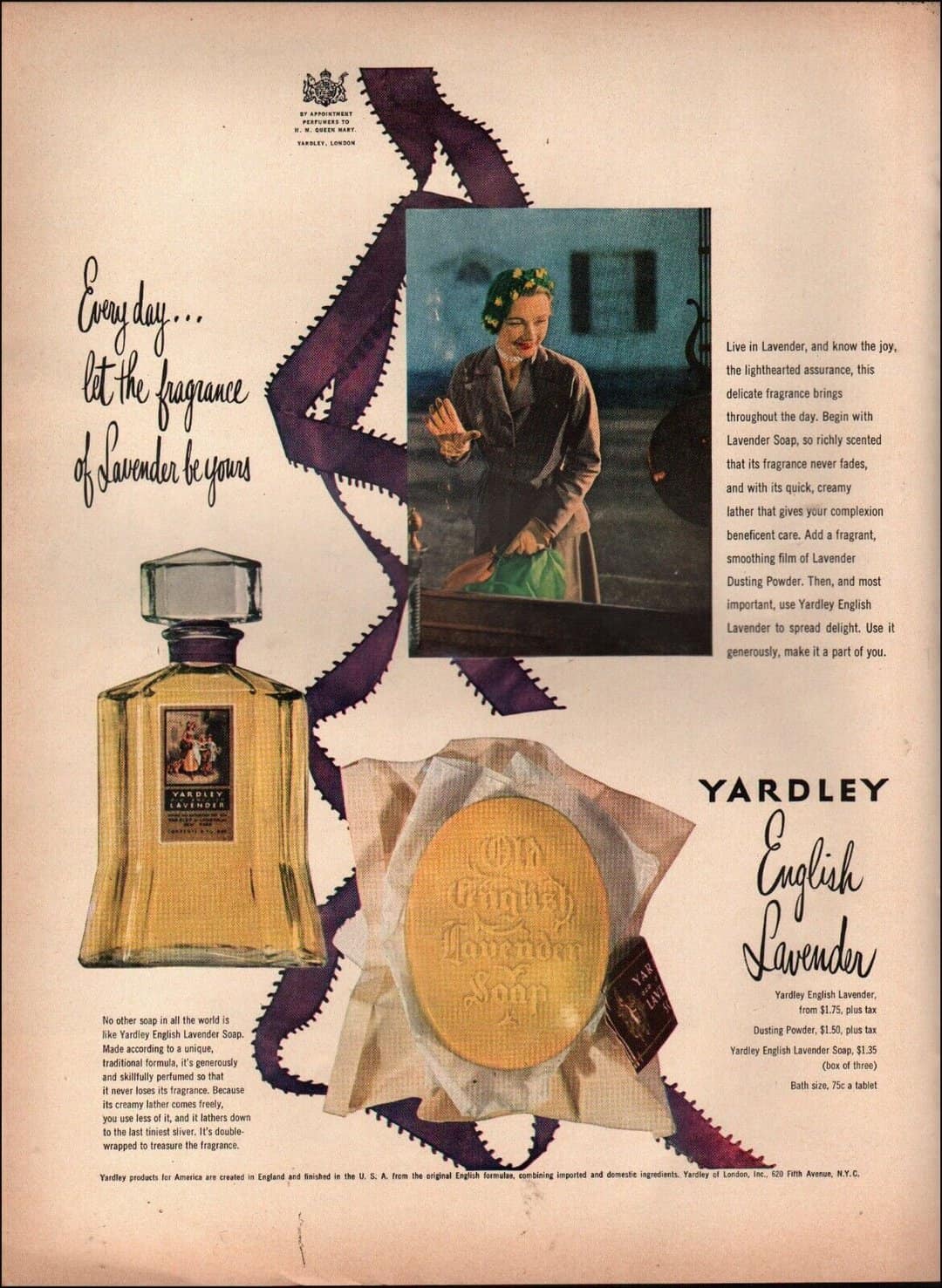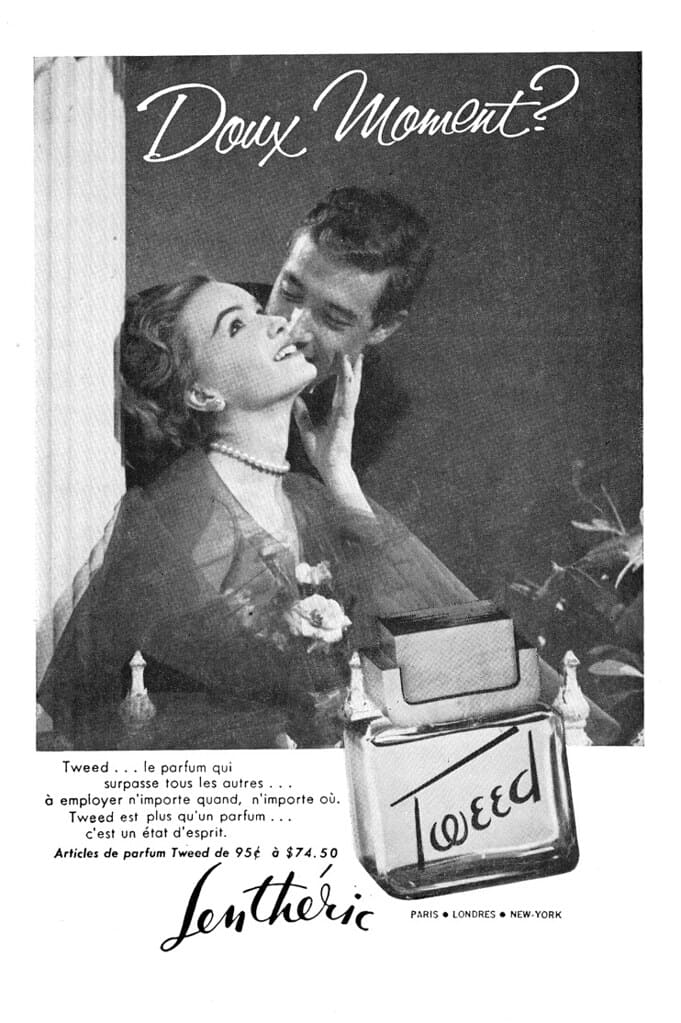Diving into the world of 1950s perfume advertisements opens a window to a time when femininity, elegance, and glamour were not just fashion statements but a deeper expression of society’s ideals and aspirations. These ads are more than just marketing materials; they’re cultural artifacts that tell the story of an era, reflecting the societal views of women and the essence of what it meant to be feminine and elegant.
At the heart of these advertisements lies a fascinating interplay between scent, imagery, and language, each element meticulously crafted to evoke a sense of luxury and sophistication. These components came together to shape perceptions and influence the era’s trends.
Five Examples of 1950s Perfume Ads
The world of perfumery is rich with history and artistry, a fact beautifully illustrated by classic fragrances that have left an indelible mark on the industry. The 1950 Yardley English Lavender retro perfume fragrance brings to mind the serene and lush countryside of England, capturing the essence of tranquility and natural beauty. It stands as a testament to the timeless appeal of lavender.

Meanwhile, the 1950 Guerlain perfume continues to epitomize luxury and sophistication, showcasing the brand’s unparalleled ability to blend exotic and rare ingredients into enchanting scents.
The 1952 Tweed, with its distinctive and bold character, mirrors the post-war era’s embrace of strength and independence, embodying a blend that is both comforting and empowering.
Yves Saint Laurent’s Libre perfume at parfumdreams, although not from the 1950s, bridges the gap between classic and modern perfumery, offering a bold reinterpretation of freedom and sophistication in scent, reflecting the brand’s continuous innovation and the evolution of women’s desires and identities through fragrance. Each of these perfumes, from their scent to their presentation, tells a unique story of their era, contributing to the rich tapestry of perfumery history.
Lastly, the iconic 1950s Chanel No. 5 perfume magazine ad not only highlights the enduring allure of this legendary fragrance but also its role in defining beauty advertising, marking it as a symbol of elegance and femininity that transcends time.

Marilyn Monroe famously declared her affection for Chanel No. 5 in an interview. When asked what she wore to bed, she provocatively responded, “Why, Chanel No. 5, of course.” This statement became one of the most celebrated endorsements in fragrance history, forever linking Monroe to the iconic scent and significantly boosting its allure and mystique.
Monroe’s candid admission highlighted her personal connection to the fragrance, making Chanel No. 5 synonymous with glamour, sensuality, and the timeless appeal of one of Hollywood’s most enduring icons.
Audrey Hepburn though closely associated with Givenchy fragrances, Hepburn’s elegance and style were in line with Chanel No. 5’s sophistication, making it a choice for many who admired her.
Scent as a Symbol of Status and Identity
In the 1950s, perfume was more than a beauty product; it was a symbol of status, a marker of identity, and a key player in the social rituals of the time. Perfume advertisements often depicted scents as the ultimate accessory, one that was essential for any sophisticated, elegant woman. These ads played a crucial role in shaping the idea that a woman’s choice of fragrance said something significant about her personality and social standing.
Visuals That Captured the Imagination
The imagery in 1950s perfume ads was nothing short of captivating. Lush, vibrant visuals were designed to transport the viewer to a world of opulence and allure. Through elegant fonts, romantic illustrations, and the strategic use of color, these ads captured the essence of the era’s femininity and glamour. Often featuring sophisticated women in luxurious settings, the visuals reinforced the connection between scent and desirability.
Language That Spoke to the Heart
The language used in 1950s perfume advertisements was carefully chosen to resonate with the aspirations and desires of women at the time. Ad copy was often poetic, filled with evocative descriptions that promised more than just a fragrance—they offered an experience, a transformation into a world of elegance and sophistication. This language not only sold perfume but also sold a dream, a vision of what life could be like with just a spritz of scent.
Key Themes in 1950s Perfume Advertising
Several recurring themes can be identified in 1950s perfume ads, each reflecting broader societal attitudes and values. These themes provide a deeper understanding of the period’s cultural landscape.

The Celebration of Femininity and Elegance
One of the most prominent themes is the celebration of femininity and elegance. Perfume ads from the 1950s often depicted women as epitomes of grace and sophistication, suggesting that these qualities could be enhanced or even acquired through the right fragrance. This theme played into the era’s ideals of womanhood, where elegance was seen as both a natural attribute and a cultivated art.
The Role of Scent in Romance and Attraction
Another significant theme is the role of scent in romance and attraction. Many advertisements suggested that the right perfume could captivate the opposite sex, making it an indispensable tool in the art of seduction. This theme reflects the period’s emphasis on romance and the importance of attracting a partner, reinforcing the idea that a woman’s value was closely tied to her desirability.
Luxury and Exclusivity
Finally, the theme of luxury and exclusivity was pervasive in 1950s perfume ads. Fragrances were often presented as rare, exotic treasures, available only to a select few. This exclusivity added to the allure of perfumes, making them coveted symbols of status and sophistication.

Impact on Society and Fashion
The influence of 1950s perfume advertisements extended far beyond the realm of beauty and fashion. They played a critical role in shaping societal attitudes towards women, beauty, and personal identity. By associating certain fragrances with ideals of femininity, elegance, and success, these ads influenced how women perceived themselves and how they were perceived by others.
Moreover, these advertisements contributed to the popularization of perfumes, making them essential items in every woman’s beauty arsenal. They also highlighted the role of scent in personal branding, a concept that remains relevant in today’s fashion and beauty industries.

Exploring the world of 1950s perfume advertisements offers invaluable insights into the era’s cultural and social dynamics. These ads were not merely selling products; they were shaping and reflecting the dreams, aspirations, and identities of a generation. Through their rich imagery, evocative language, and thematic depth, they remind us of the power of advertising to influence culture and fashion.
In a way, these advertisements are time capsules, preserving the essence of the 1950s femininity and glamour. They invite us to reflect on how much has changed and how much remains the same in the ways we think about beauty, identity, and the art of seduction. As we look back on these vintage ads, we’re reminded of the enduring allure of perfume and its ability to captivate, transform, and enchant, just as it did over half a century ago.
